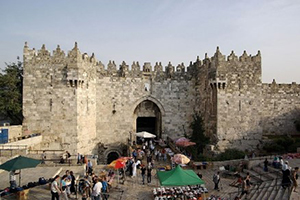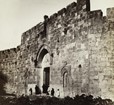By Gedaliah Borvick

JERUSALEM — From time immemorial until the late nineteenth century, almost all of Jerusalem’s residents lived in the walled Old City. Divided into four uneven quadrants – the Jewish Quarter, the Muslim Quarter, the Christian Quarter and the Armenian Quarter – the Old City looms large due to its rich and multi-layered history, but it is actually quite small, at slightly less than 4/10 of a square mile. To give you a sense of perspective, it is less than 1% the size of modern Jerusalem.
The current wall encircling the Old City was built in the sixteenth century by Suleiman the Magnificent of the Ottoman Turkish Empire. Over the years, access gates were added to the wall. Let’s discuss the names of these gates.
One of the main entrances to the Old City is Jaffa Gate. This gate is on the western side of the Old City and is aptly named, as it is the end of the highway that starts at the Jaffa Coast.
Located along the southern wall, Dung Gate is closest in proximity to the Temple Mount. It gained its inauspicious name because refuse from the Temple was removed from the city via a nearby gate.

Damascus Gate is one of the busiest and most magnificent gates. It is located on the northwest side where the highway leads out to Nablus (the gate’s Arabic name), and from there to Syria’s capital, Damascus.
The Flower Gate, which enters the Muslim Quarter, received its name because rosette stone adorns the gate tower. It is also known as Herod’s Gate because Saint Peter was incarcerated nearby by Herod Agrippa.
Built in 1887 and offering access to the Christian Quarter, the New Gate received its name because it is the newest gate and because it leads to the new neighborhoods outside the Old City.
Lions Gate is on the eastern wall and four lion figures adorn the gate. During the Six Day War, Israeli paratroopers stormed through this gate to conquer the Temple Mount.
The oldest gate is the Gate of Mercy, also known as the Golden Gate. Now sealed shut, it is on the eastern side of the Old City and faces the Mount of Olives. Some claim that the Messiah will enter Jerusalem via this gate.
The sealed Huldah Gates along the southern wall are comprised of two sets of multiple-arched gates. “Huldah” is either derived from the Hebrew word mouse, as the gates look like mouse tunnels, or from Huldah the Prophetess who held court in this area and was buried nearby.

Located on the southern wall, Zion Gate leads to the Jewish Quarter and was one of the main gateways used by the IDF when they miraculously captured the Old City in the 1967 Six Day War. Zion is one of the names of the hill where the Temple stood; its other names are Har Hamoriah and Har Habayit.
According to Jewish tradition, the sanctity and centrality of the Temple Mount was made apparent through a series of seminal events, serving as the site where (1) God began creation, (2) Adam brought the first offering to God, (3) Noah offered a thanksgiving offering after the flood, and (4) Abraham brought his son Isaac as an offering.
How does one not get chills thinking about the holiness, majesty and rich history of the Old City?
*
Gedaliah Borvick is the founder of My Israel Home (www.myisraelhome.com), a real estate agency focused on helping people from abroad buy and sell homes in Israel. To sign up for his monthly market updates, contact him at gborvick@gmail.com.